There seem to be two categories of people: those who’ve never heard of ventless dryers and those who’ve never heard of vented dryers. As you can imagine, each dryer type has pros and cons. So, it’s not a question of which is best; it’s more about which is best for you. But if you’ve only ever known about one type of dryer, then where do you even start the comparison? Well, you can start here!
Differences between vented and ventless dryers include price, drying time, load capacity, energy efficiency, and more. Below, I go over which dryer excels in each category, several types of each kind of dryer, as well as what scenarios a vented or ventless dryer would be suited for.

Vented dryers are less expensive, take bigger loads, dry clothes faster, and are less likely to impact the room’s humidity. Ventless dryers are easier to install and maintain, have greater variety and energy-efficiency, are gentler on clothes, last longer, and pose a smaller fire risk.
Average Purchase Price
Vented dryers, because they are much more common (in the USA), are often cheaper than ventless dryers, which are less common (in the USA).
The price range of vented dryers ranges from about $300 to $1,500, while a ventless dryer, such as a condenser dryer, has a higher range of $600 to $2,000.
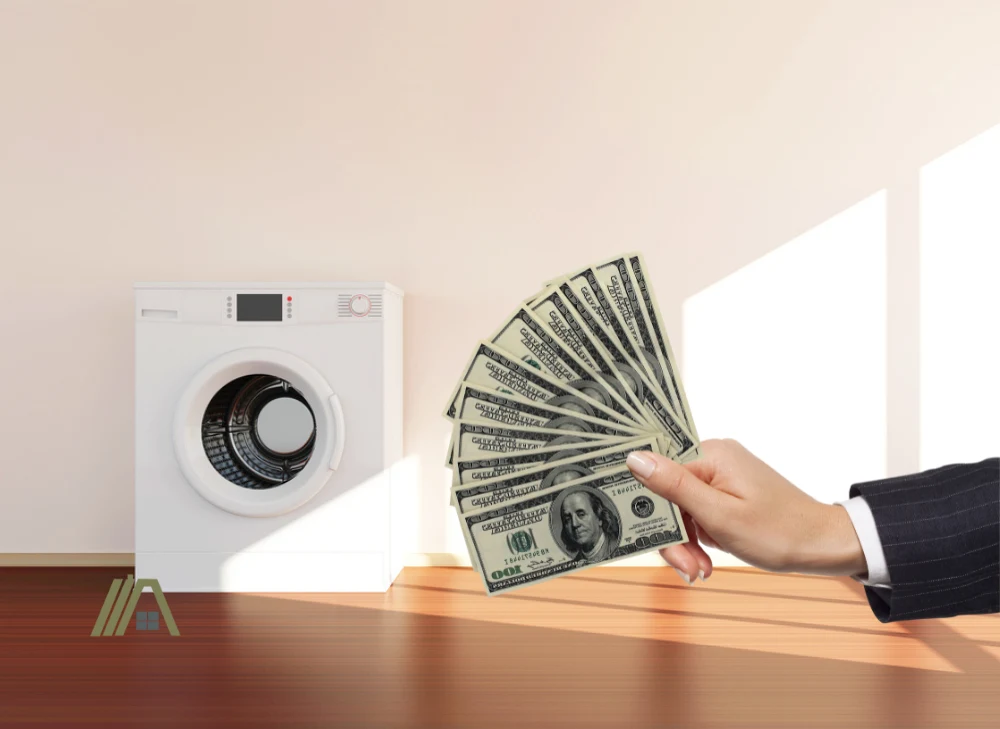
On average, a vented dryer will cost less than a ventless dryer.
This is partially due to how common they are, at least in the U.S. In Europe, ventless dryers are the norm since they are much more space-efficient (even more so when stacked atop the washer). In the States, vented dryers are more commonplace since homes can accommodate their larger size more often.
Because they are somewhat of a rarity in the States, the price of a ventless dryer would naturally be higher.
Ventless dryer prices are often high without the rarity factor, though. This is most likely due to how the dryers are made. Their components and systems are more expensive and newer than their vented counterparts, so their selling price must be more expensive.
However, they may end up being more cost-effective in the long run.
Variety and Mechanism
Vented Dryers
Gas Dryers
A gas dryer is one of two types of vented dryers.
The mechanism through which they dry clothes relies on two factors: heat and spin.
The heat of a gas dryer is generated by a flame. This flame is ignited when the dryer begins its cycle. After the tumbler has spun for a few seconds, the pilot light, similar to the pilot light of a gas oven, ignites a flame. This flame heats up the air in the dryer.
The spin of a gas dryer occurs through a belt and pulley system.
Together, the heat and the spin evenly dry the clothes as water is removed from them as steam. This steam exits the system through the dryer’s exhaust or ventilation system.
Ventless dryers cannot be gas-powered because of the risk of carbon monoxide release and subsequent poisoning of a home’s inhabitants.
Electric Dryers
The second type of vented dryers would be electric dryers.
They also work through a combination of heat and spin.
For electric dryers, heat is generated through heating coils similar to electric ovens and hot water heaters. The resistance of the coils builds up heat, which is then blown through the dryer with a blower or fan.
Electric dryers also spin with a belt and pulley system.
As with gas dryers, both the heat and the spin of an electric dryer evenly dry the clothes as the water is removed as steam and pushed out of the system through the exhaust.
Ventless Dryers
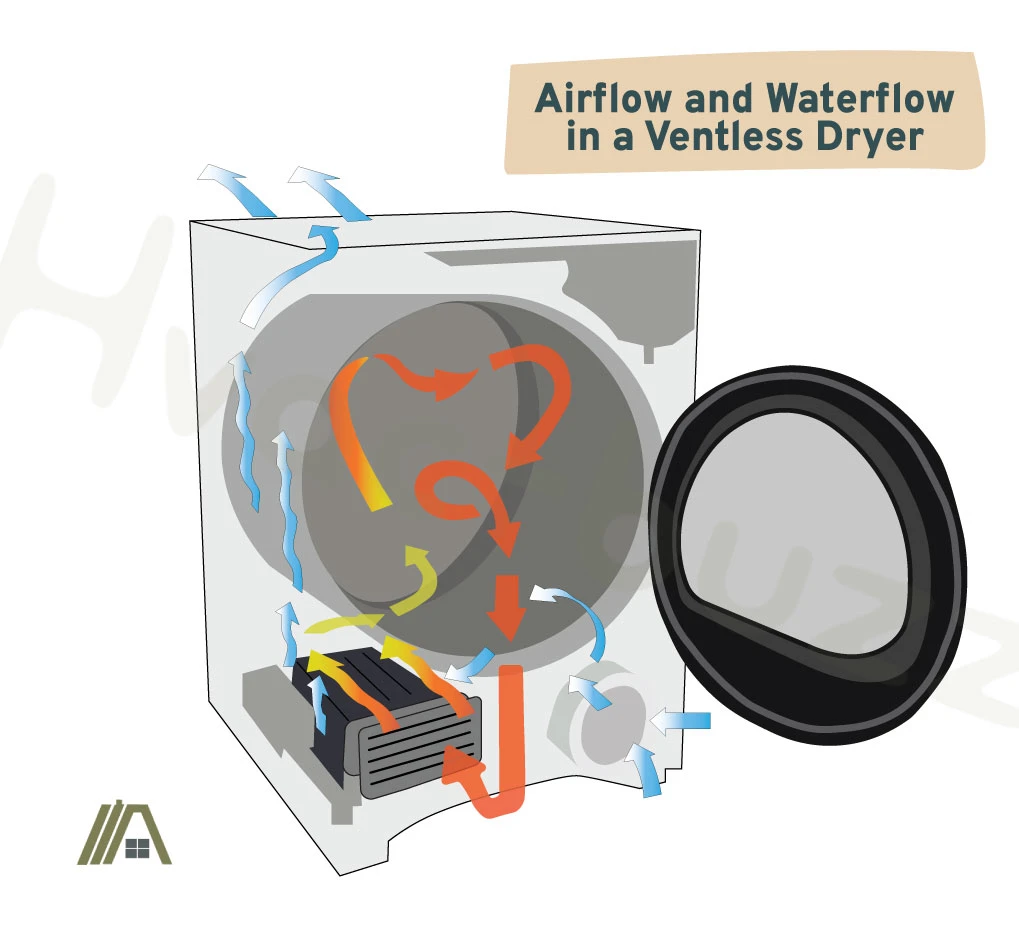
Condenser Dryers
One of the two main types of ventless dryers is the condenser dryer, which utilizes heat exchange to dry clothing.
First, heated air is blown towards the wet clothing so that the moisture evaporates. Then, through heat exchange, the hot and humid air is condensed through cooling. This water is then removed from the laundry load to either a storage tank or through a drain pipe.
A collection tank must be emptied every so often to prevent overflowing and leaking.
Heat Pump Dryers
The second type of ventless dryer is the heat pump dryer.
They run very similarly to condenser dryers because they use heat exchange to heat the moisture and then condense it to remove it.
The difference between the two lies in the heating and cooling mechanisms. Condenser dryers use heating elements to warm the air. Heat pump dryers use a coolant. This coolant runs through a closed system of coils and is compressed to increase in temperature. The air is passed over these coils and the heat is transferred into the air.
Spin Dryers
These dryers are also known as centrifuge dryers and are a less common kind of ventless dryer.
They spin through the same process as a vented tumble dryer but much faster and there is no air involved, which is why they can be ventless. I know! I was also interested to discover these appliances.
The intense spinning removes a large amount of water in a short amount of time (only about 3-5 minutes), but the clothes aren’t completely dry in the end.
Steam Compression Dryers
These are another less common type of ventless dryer. They work similarly to heat pump dryers since the extracted water is recycled.
To remove moisture from your laundry, a steam compression dryer uses steam that was generated by the heating of water extracted from previous loads.
Combo Dryers
A combo dryer refers to a singular machine that can be used for both washing and drying clothes.
They can be either ventless or vented.
For vented combo dryers, heated air from the room and a spinning drum evenly dry the clothing after it has been washed.
For ventless combo dryers, they most often use the same process as condensing dryers. Once the clothes are washed, they are cooled, heated to produce humid air, and then cooled again so that the water can condense and be removed.
Ease of Installation
Overall, ventless dryers are significantly easier to install because they do not require venting.
Both vented and ventless dryers must have the correct three-pronged outlet connection so that they are provided with enough electricity to run properly. Other than plugging in your ventless dryer, the installation doesn’t require much else.
Note: some electric dryers have a four-prong plug.
For vented dryers, on the other hand, ventilation must be installed, which is a lengthy and difficult process.
The vent path must be carefully mapped out and measured first. The vents should be placed so that they are as short and straight as possible to make the process easier and ensure code compliance.
Then, the vent hood opening and other openings must be made so that the path of the ductwork is clear. Be sure that the vent hood opening is at least 12 inches from the ground and that holes made in the home are clear of wiring, ducts, or pipes before you make them.
The dryer vent hood must then be installed.
I recommend the Calimaero Stainless Steel External Air Vent (amazon link) for its stellar reviews and durability.
The vents must then be cut and installed. Once this is done, they must be tested.
Overall, this project is not an easy feat. It can easily take you hours or even a full day and it can be fairly difficult.
Ventless dryers do not require this process and are also quite easy to fit into your home.
Furthermore, because they do not require ventilation, their placement does not rely on the location of venting in the home. Ventless dryers are also often more compact than vented dryers, so they are easier to fit into various areas of the home.
Drying Time
Heat Pump Dryers Are Slower Than Other Dryers
Heat pump dryers are the most energy-efficient dryer models. This is because they operate at a relatively low temperature compared to both condenser and vented dryers.
Since drying time is largely influenced by the temperature in the drum, it shouldn’t come as a surprise that vented dryers do not take up as much time as ventless units to dry clothes.
Heat pump units do not have a heating element. Instead, they operate in a manner similar to refrigerators and air-conditioning units.
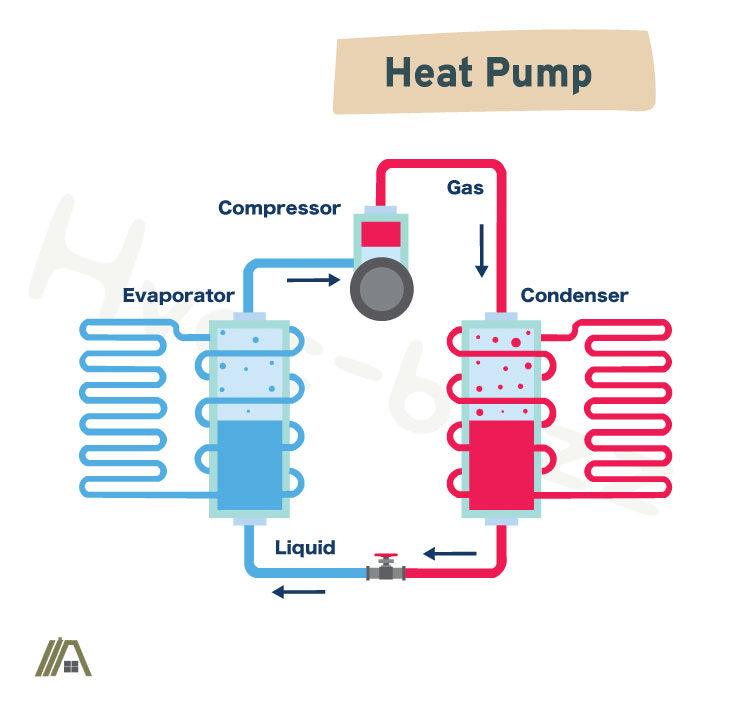
Firstly, the air drawn from the room is heated with the help of compressed refrigerant inside the condenser coils. Then it passes to the drum to dry the clothes.
Later, an uncompressed refrigerant in an evaporator cools the hot, moisture-filled air in order to relieve the air of its moisture. The air then again passes over condenser coils, where it’s reheated before it can be sent back into the dryer drum.
Replacing the heating element with heat pump technology makes for a reduced internal temperature in the drum and high energy efficiency. However, drying clothes at a lower temperature means that the clothes would take longer to dry.
Heat pump dryers are actually the slowest of all the dryer types. They typically take 15-20 minutes more than condenser units to dry identical laundry loads.
They usually take about 30-50 more minutes longer compared to vented dryers, and in some situations, they could even take double the drying time of a vented dryer.
Condenser Dryers’ Speed Is Slightly Higher
Although condenser dryers are similar to heat pump dryers in that they do not feature a vent, there are slight differences in their operation.
Like vented models, condenser dryers feature a heating element. This implies that the dryer temperature, although slightly lower than vented units, is still relatively high compared to the temperature of heat pump dryers, which do not use an electric heating element.
In fact, while condenser dryers feature a heating element and tend to run at around 158 °F (70 °C), heat pumps utilize the heat pump technology that allows them to run at only around 122 °F (50 °C).
This makes condenser dryers a preferred middle ground between the energy efficiency of heat pump dryers and the swift operations of vented dryers. However, it also means that condenser dryers are not as gentle on clothes as heat pump dryers.
Load Capacity
Although ventless dryers are often favored for their smaller size, this can be a problem for the size of loads they can handle.
Most vented dryers have a load capacity of about 7 cubic feet. Ventless dryers, on the other hand, often have a load capacity of only 4 cubic feet, so nearly only half of the capacity of vented dryers.
This means that you will have to do more laundry loads with a ventless dryer than a vented one. Laundry that would already take longer in a ventless dryer would need to be split up into more loads.
Impact on Fabrics
As far as how gentle each kind of dryer is on your clothing, ventless dryers are far more gentle.
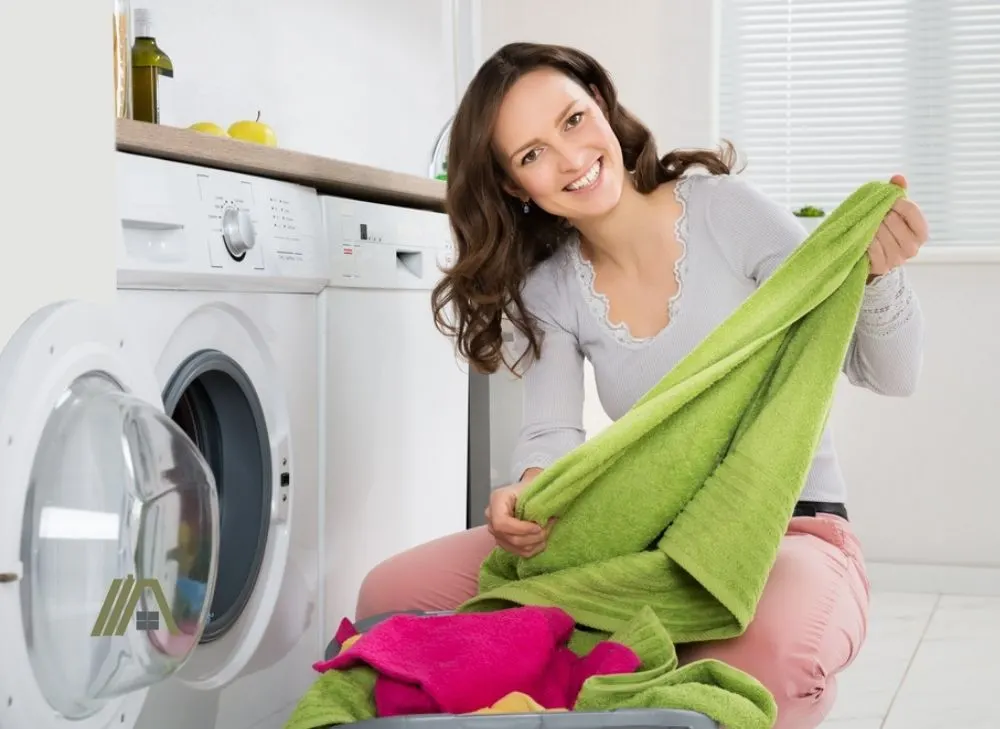
This stems mainly from the fact that both condenser and heat pump dryers operate at a lower temperature than vented dryers.
At higher temperatures, fabrics are more likely to experience wear and tear and lint will accumulate. This lessens the quality of the clothing and also increases the risk of fire hazards.
Energy–Efficiency
Ventless dryers are far more energy-efficient than vented dryers because they don’t require venting and operate at lower temperatures than vented dryers.
As you ventilate your home more and more, the energy costs to keep your home at a comfortable temperature with increase. This is because your home is becoming less and less airtight as holes are being cut for vents.
This will allow for air to infiltrate your home as well as escape it. Your HVAC system will have to accommodate for this loss and therefore your energy bills are likely to increase.
However, this loss of conditioned air or uncontrolled entry of air is minimal in comparison to the fact that a vented dryer literally takes your conditioned room air, uses it, and spits it outside over and over again while the dryer runs.
This means that your interior environment is never stable and the HVAC system has to work hard to stabilize it.
You don’t have to worry about this with condenser and heat pump dryers. These dryers also require lower temperatures to work properly. This means less electrical demand.
Condenser dryers require less energy than vented dryers but heat pump dryers require just half of what vented dryers need.
Vented Vs Ventless Cost per Load Compared

It costs $0.14-0.16 to run one load in a ventless heat pump dryer and $0.37-0.56 in a ventless condenser dryer. It costs $0.13-0.20 to run the same load in a vented gas dryer and $0.34-0.45 in a vented electric dryer.
How Much Power Do Dryers Use?
The amount of energy your dryer consumes will be reflected in the dryer unit’s wattage. The wattage of a dryer determines how much electricity travels through a circuit per second, so the higher the wattage, the more power is consumed.
Here is a table showing the average wattage of the different dryer types.
| Dryer | Watt |
| Ventless Heat pump | 800 |
| Vented Gas* | 1800 |
| Ventless Condenser | 3000 |
| Vented Electric | 3000 |
Why Heat Pump Dryers Use Less Electricity
Heat pump dryers are the most energy-efficient dryers on the market, making them a great fit for people keen on energy saving. In fact, they’ve been known to consume 40- 50% less electricity than conventional electric dryers.
Their lower energy consumption is owing to the unique heat pump technology that the dryer adopts. Unlike regular dryers, which use a heating element to dry clothes, heat pump dryers use a refrigerant contained within coils to heat the air that is used to dry clothes.
The entire process of heating the air consumes minimal electricity. There are still motors, lights, and control panels that need to be run, but the actual heating process consumes far less energy than a heating element would
Cost to Dry a Load of Washing
Taking all these factors into consideration (unit wattage, drying time, and cost of electricity, let’s look at the cost of drying a load of washing.
Below is a table showing the average cost per load of the different dryer types. The calculations are based on the average drying time, wattage, and the US average cost of electricity discussed in previous sections of this article.
| Dryer | kWh | Cost to dry 1 load of washing ($) |
| Ventless Heat pump | 0.9-1.07 | 0.14-0.16 |
| Vented Gas | 0.9-1.35 | 0.13-0.20 |
| Vented Electric | 2.25-3.0 | 0.34-0.45 |
| Ventless Condenser | 2.5-3.75 | 0.37-0.56 |
To calculate the cost, of running your dryer, here are the steps to follow:
- Divide the wattage of your dryer by 60 minutes. E.g., a 2500-watt dryer would use 41.6 watts per minute.
- Time how long your dryer takes to dry a load of laundry.
- If your dryer takes over an hour to dry washings, convert the time to minutes and multiply the time by the wattage per minute. This helps you get the watts per load.
- Convert to kilowatt by dividing the wattage by 1000.
- Check for the cost of electricity in your locality and multiply the amount by the kilowatt per load.
Monthly and Yearly Costs
The monthly or yearly cost of running your dryer would depend on how often you use the unit. For instance, even if they are using the same type of dryer, the monthly drying cost of a household that dries 6 loads of laundry weekly would definitely be more than that of a family that dries 3 loads of washing weekly.
Using the information provided in previous sections of this article, I’ve put together a table showing the average energy cost of the different dryer types based on 4 loads a week.
| Dryer | Monthly cost | Yearly cost |
| Ventless Heat pump | 2.24-2.56 | 26.88-30.72 |
| Vented Gas | 2.21-3.4 | 27.04-41.6 |
| Vented Electric | 5.78-7.65 | 70.72-93.6 |
| Ventless Condenser | 6.29-9.52 | 76.96-116.48 |
Use and Maintenance
The ease of use difference between vented and ventless dryers is fairly minor since loading and selecting settings are fairly similar for each one.
The only aspect that would complicate use is that ventless dryers often have many more settings for drying, such as wool, baby clothes, and other specific types of fabric.
If you are not used to these specific settings, using a ventless dryer may be complicated the first few times around. This may not always be the case though. Settings can differ by brand.
The maintenance differences between these two are much more obvious.
For ventless dryers, it is likely that you will have to empty the tank where the water collects after a cycle. It is important to do this often so that the tank level does not exceed its limits. However, there is often the option of plumbing the dryer in.
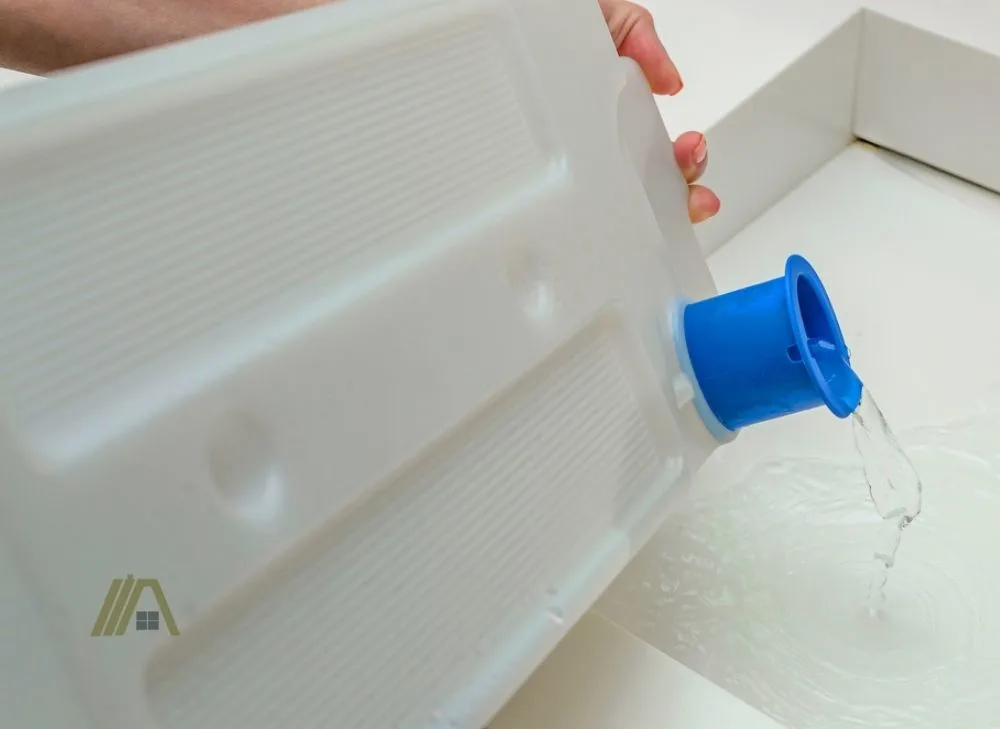
Alternatively, you can get creative with reusing dryer water and reduce your water usage.
The only other maintenance for ventless dryers is the fact that their lint traps must be emptied out every month or so. Dryer lint traps in vented dryers need to be emptied out far more often, after each cycle, to prevent fire hazards.
But maintenance doesn’t end here. Dryer vents must also be cleaned at least yearly and this process can be long and cumbersome. If this is not done when needed, the lint produces fire hazards.
Overall, ventless dryers require far less maintenance.
Average Lifespan
While vented dryers usually last only 10-13 years, ventless dryers can last 20 years or more.
Part of the reason for this is because of lint build-up.
In vented dryers, lint is much more of a problem. While ventless dryers only need to be cleared of lint monthly, vented dryers must be cleared of lint after each cycle.
Vented dryers are likely to experience more lint problems because they use higher temperatures.
With more lint accumulation, the dryer ducts become clogged and less air can get through the ducts. This affects the efficiency of the dryer and causes it to work harder. A dryer that works harder will also have a shortened lifespan.
Ventless dryers also have more updated technology than vented dryers do. More advanced dryers are likely to last longer.
Health and Safety Considerations
While vented dryers have their hot, humid air vented outside, ventless dryers condense and collect all the water removed from clothing. Dryers aren’t air-tight, though, and some humid air may seep into your home.
As such, ventless dryers can increase the humidity of a room. However, I do want to point out that ventless dryers are code-compliant and the increase in humidity is only significant if there is no ventilation in the room.
Even just opening the laundry door so that the air can flow between the laundry and adjacent rooms should be enough to keep this in check.
If you don’t keep the room ventilated and you run several loads one after the other, then the higher humidity in the room can lead to uncomfortable conditions and mold growth.
In this scenario, it would be wise to purchase a dehumidifier. I recommend the Pohl Schmitt Electric Dehumidifier (amazon link) for its affordable price and manageable size.
As far as fire risk goes, both types of dryers may cause fires since they are appliances that have a high electrical demand. Most of this risk comes from the flammable lint that accumulates in all dryers.
Although ventless dryers do accumulate lint, they accumulate far less than vented dryers do. Vented dryers accumulate more due to their higher temperatures.
Vented dryers also accumulate lint both in their lint traps and in their vents. Because this accumulation not only provides fires with flammable material but can also cause the dryer to overheat due to duct blockage, vented dryers are at a higher risk of fires than ventless dryers.
Should I Buy a Vented or Ventless Dryer?
Each type of dryer has its individual advantages and disadvantages, which makes it possible that one dryer would be great for one situation but not another. One is not better than the other since their advantages heavily rely on what the situation is.
That being said, it is wise to consider what kind of environment the dryer will be in as well as your personal priorities.
For example, a ventless dryer may take longer to dry a load and is often more expensive, but it is also more energy-efficient and easier to install.
Below are some situations where a certain location or situation determines which dryer would be more advantageous.
- Best for master closets: Ventless Dryer
A master closet could be a great place for a dryer since your laundry can be put away very easily. Unfortunately, master closets may have less space than a laundry room would. They also may not be close to an outside wall where exhaust can be easily vented.
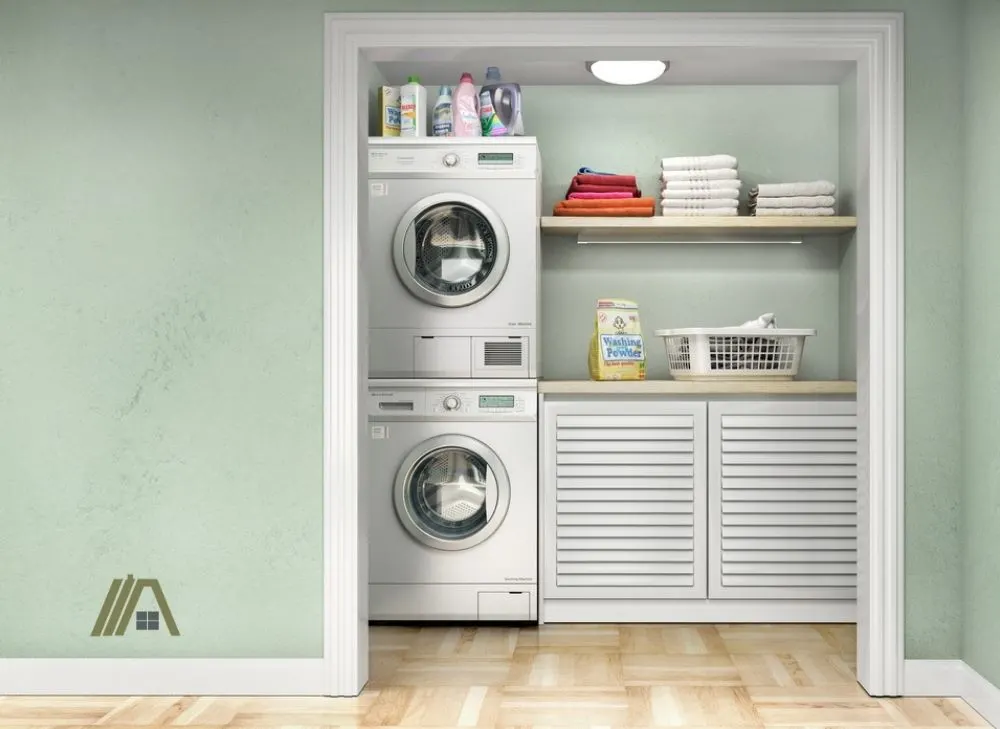
A ventless dryer is ideal for this situation since it is both compact and does not need to be vented.
- Best for small houses: Ventless Dryer
In a small house, it is wise to save as much room as possible as far as where and how your appliances are placed. A ventless dryer is ideal for this because it is much more compact and easy to install than a vented dryer.
- Best for large families: Vented Dryer
In a large family, costs for school, food, and other living expenses are often higher with each child and adult that lives in the home. This is where a vented dryer comes in handy since they are often less expensive than ventless dryers.
A larger family also means more dirty laundry. Vented dryers often have higher capacities, so you don’t have to do as many loads of laundry in your large household.
- Best for businesses: Vented Dryer
Dryers are a business expense, so it is wise to factor in cost heavily when you are choosing a dryer. Vented dryers are less expensive than ventless dryers.
They also have a higher load capacity and dry in a shorter period of time, which will keep your employees and/or customers happy.
- Best for mid-house rooms: Ventless Dryer
In a mid-house room, it would be very difficult to vent dryer exhaust to the outside of your home. You may have to go through several walls. This is where a ventless dryer would be advantageous since they do not require any ducting.
If you have made your decision and chosen to go with a ventless dryer, I recommend having a read through my article comparing the two most common ventless models: condenser dryers and heat pump dryers.
Sources
https://www.reviewed.com/laundry/features/everything-you-need-to-know-about-ventless-dryers
https://homesteady.com/13410680/how-does-a-gas-dryer-work
https://www.thespruce.com/how-does-a-clothes-dryer-work-2145846
https://home.howstuffworks.com/washer-dryer-combos.htm
https://www.homedepot.com/c/ah/how-to-install-a-dryer-vent/9ba683603be9fa5395fab907b927963
https://fredsappliance.com/service/comparing-different-types-ventless-clothes-dryers/
https://www.buildwithrise.com/stories/pros-and-cons-of-ventless-clothes-dryers
https://www.reviewed.com/laundry/features/everything-you-need-to-know-about-ventless-dryers
https://www.pcrichard.com/vented-vs-ventless-dryers-whats-the-difference/Blog-9873.html
https://www.shipitappliances.com/blog/ship-happens/how-to-install-a-tumble-dryer/



